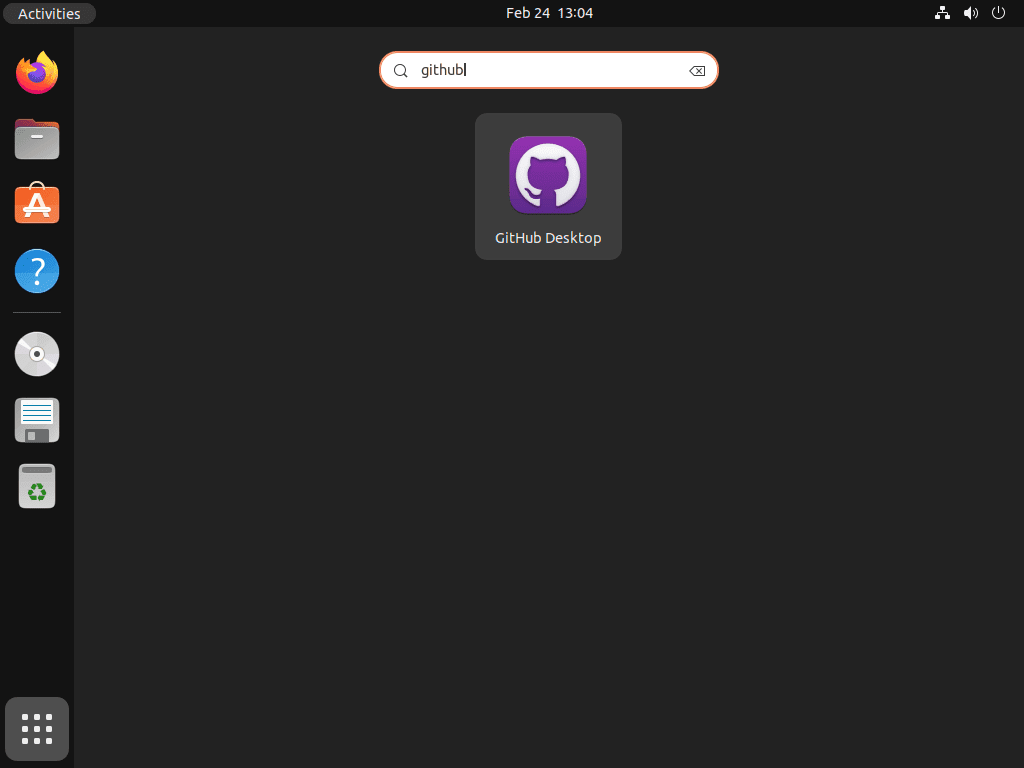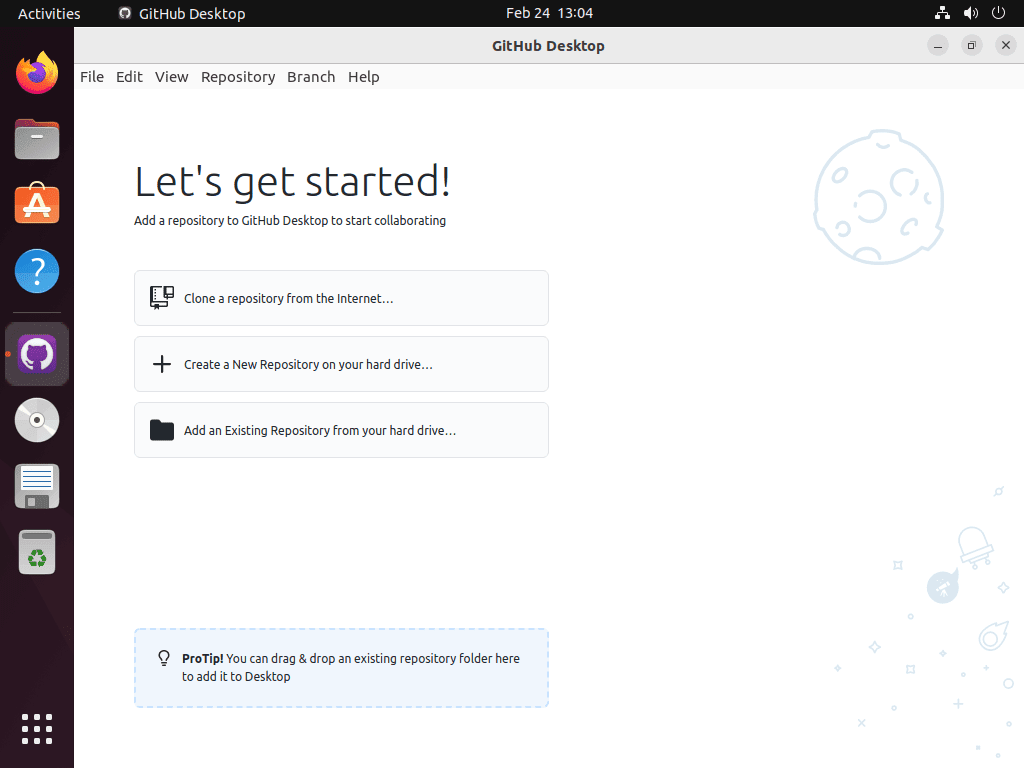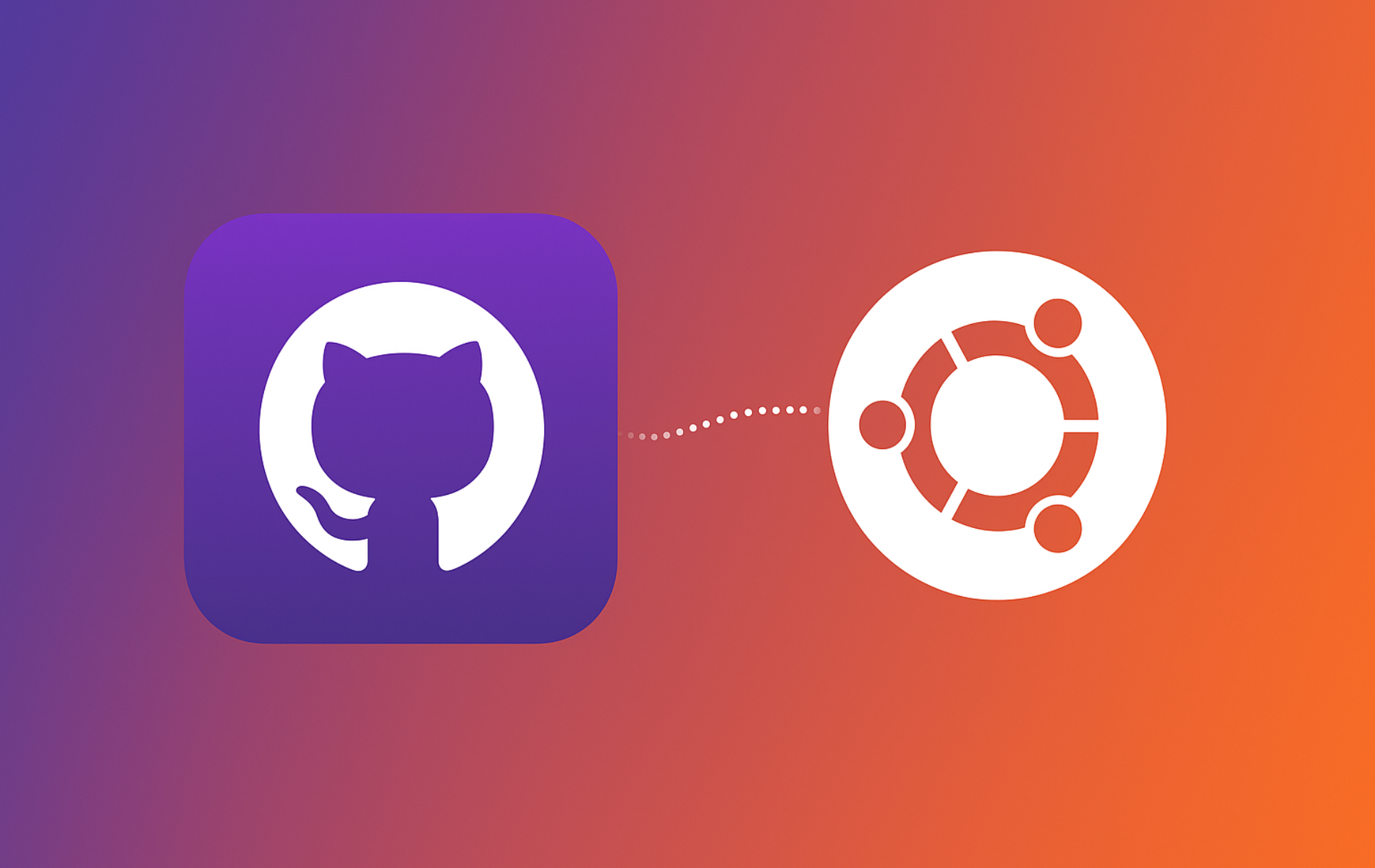GitHub Desktop provides a graphical interface for Git version control, making it easier to commit changes, create branches, manage pull requests, and collaborate on projects without memorizing command-line syntax. Whether you are new to version control or prefer a visual workflow, GitHub Desktop streamlines repository management on your Ubuntu system. While GitHub does not officially support Linux, the community-maintained shiftkey/desktop fork packages GitHub Desktop for Linux distributions with regular updates and full feature parity.
This guide covers three installation methods: manual .deb package installation for version pinning, APT repository configuration for automatic updates, and Flatpak installation for sandboxed deployment. By the end, you will have a working GitHub Desktop installation ready to clone repositories, create branches, commit changes, and manage pull requests through a visual interface.
Choose Your GitHub Desktop Installation Method
GitHub Desktop can be installed through several channels on Ubuntu. Each method has different trade-offs for maintenance and update frequency.
| Method | Channel | Stability | Best For |
|---|---|---|---|
| Manual .deb | shiftkey/desktop releases | Manual updates | Users who want control over when to update or need to pin specific versions |
| APT Repository | Community-maintained | Automatic via apt upgrade | Most users who prefer hands-off updates alongside system packages |
| Flatpak | Flathub | Automatic via flatpak update | Users who prefer sandboxed applications with isolated dependencies |
For most users, the APT repository method provides the best balance of convenience and reliability. Flatpak offers additional sandboxing if you prefer isolated applications. Ubuntu systems with SSH-based Git workflows benefit from configuring SSH authentication alongside GitHub Desktop for seamless credential management.
Update Ubuntu Before GitHub Desktop Installation
Before proceeding, verify your system architecture to ensure you download the correct package variant:
dpkg --print-architectureamd64
Most modern Ubuntu systems report amd64. Raspberry Pi and ARM-based systems show arm64 or armhf. Once confirmed, update your system before adding new software to ensure package dependencies resolve correctly:
sudo apt update && sudo apt upgradeInstall GitHub Desktop on Ubuntu
Option 1: Install GitHub Desktop via .deb Package
The manual .deb method gives you direct control over which version to install. First, set a VERSION variable with the latest release tag from the shiftkey/desktop releases page, then download the matching package:
VERSION="3.4.13-linux1"
wget https://github.com/shiftkey/desktop/releases/download/release-${VERSION}/GitHubDesktop-linux-$(dpkg --print-architecture)-${VERSION}.debCheck the releases page for the current version to assign to
VERSION. The$(dpkg --print-architecture)placeholder automatically detects your system architecture (amd64, arm64, or armhf).
Install the downloaded package with apt so dependencies resolve automatically:
sudo apt install ./GitHubDesktop-linux-$(dpkg --print-architecture)-${VERSION}.debVerify the installation succeeded by checking the version:
github-desktop --version3.4.13-linux1
Option 2: Install GitHub Desktop via APT Repository
Two community-maintained APT repositories mirror the shiftkey/desktop project, both hosted in the United States. This method integrates GitHub Desktop into your standard system update workflow, updating automatically through apt upgrade commands.
The Mwt mirror is currently recommended as the primary installation source. The official Shiftkey repository (
https://apt.packages.shiftkey.dev) is experiencing SSL certificate issues where it presents a mismatched*.azureedge.netcertificate instead of a valid certificate for its domain. This Azure CDN configuration error prevents secure HTTPS connections until resolved. Both mirrors ship identical packages and use the same GPG signing key.
Import Mwt GitHub Desktop Mirror (Recommended)
The Mwt mirror is fully operational with valid SSL certificates and uses the same package signing key as the upstream Shiftkey repository. First, download and convert the GPG key. The gpg --dearmor command converts the ASCII-armored key to binary format required by APT:
sudo install -m 0755 -d /usr/share/keyrings
curl -fsSL https://mirror.mwt.me/shiftkey-desktop/gpgkey | gpg --dearmor --batch --yes | sudo tee /usr/share/keyrings/mwt-desktop.gpg > /dev/nullThe
gpgcommand requires the gnupg package, which is installed by default on desktop Ubuntu systems. Minimal server installations may need to install it first withsudo apt install gnupg.
Add the repository using modern DEB822 format with shell expansion for automatic architecture detection:
cat <<EOF | sudo tee /etc/apt/sources.list.d/mwt-desktop.sources
Types: deb
URIs: https://mirror.mwt.me/shiftkey-desktop/deb/
Suites: any
Components: main
Architectures: $(dpkg --print-architecture)
Signed-By: /usr/share/keyrings/mwt-desktop.gpg
EOFCommands shown work on all current Ubuntu releases (22.04 LTS and newer). Both community-maintained mirrors use universal repository configurations that support all active Ubuntu versions.
Import Shiftkey GitHub Desktop Mirror (Alternative – Currently Experiencing SSL Issues)
The official Shiftkey repository is currently presenting an SSL certificate for
*.azureedge.netinstead ofapt.packages.shiftkey.dev, causing certificate validation failures. This is an Azure CDN configuration issue that prevents secure HTTPS connections. Use the Mwt mirror above until this issue is resolved. Only attempt these commands if you have confirmed the SSL certificate has been fixed by runningcurl -I https://apt.packages.shiftkey.dev/gpg.keyand receiving an HTTP 200 response without certificate errors.
If the SSL certificate issue has been resolved, download and convert the GPG key:
sudo install -m 0755 -d /usr/share/keyrings
curl -fsSL https://apt.packages.shiftkey.dev/gpg.key | gpg --dearmor --batch --yes | sudo tee /usr/share/keyrings/shiftkey-packages.gpg > /dev/nullAdd the repository using modern DEB822 format with shell expansion for automatic architecture detection:
cat <<EOF | sudo tee /etc/apt/sources.list.d/shiftkey-packages.sources
Types: deb
URIs: https://apt.packages.shiftkey.dev/ubuntu/
Suites: any
Components: main
Architectures: $(dpkg --print-architecture)
Signed-By: /usr/share/keyrings/shiftkey-packages.gpg
EOFComplete Repository Installation
After adding either repository, refresh the package lists to include the new repository:
These commands stay in lockstep with the upstream shiftkey/desktop repository documentation while preserving LinuxCapable’s DEB822 .sources conventions and tightened keyring handling.
sudo apt updateFinally, install GitHub Desktop from the repository:
sudo apt install github-desktopVerify the installation succeeded:
github-desktop --version3.x.x-linuxX
Option 3: Install GitHub Desktop via Flatpak
Flatpak delivers GitHub Desktop in a sandboxed container with isolated dependencies. This approach provides consistent behavior across Ubuntu versions and other distributions while maintaining application security through restricted system access.
If Flatpak is not installed on your system, follow the Flatpak installation guide for Ubuntu to install the runtime and configure system repositories before proceeding. This enables universal package installation across distributions.
Enable Flathub Repository
Add the Flathub repository system-wide to access the GitHub Desktop package:
sudo flatpak remote-add --system --if-not-exists flathub https://flathub.org/repo/flathub.flatpakrepoInstall GitHub Desktop via Flatpak
Next, install GitHub Desktop from Flathub:
sudo flatpak install --system -y flathub io.github.shiftey.DesktopVerify the Flatpak installation:
flatpak list | grep -i githubGitHub Desktop io.github.shiftey.Desktop 3.x.x system
Launch GitHub Desktop
Launch GitHub Desktop from Terminal
To launch from the terminal, start GitHub Desktop with the following command:
github-desktopFor Flatpak builds, the runtime requires the full application ID:
flatpak run io.github.shiftey.DesktopLaunch GitHub Desktop from Application Menu
You can also access GitHub Desktop through the standard application menu by searching for “GitHub Desktop” in your desktop environment’s application launcher.


Manage GitHub Desktop Updates and Removal
Update GitHub Desktop
Update procedures vary by installation method. Flatpak and APT repository installations receive updates automatically through their respective package managers, while manual .deb installations require downloading new releases.
To update Flatpak installations system-wide, run:
sudo flatpak update --systemFor APT repository installations, GitHub Desktop updates alongside other system packages:
sudo apt update && sudo apt upgradeHowever, manual .deb installations require downloading the latest package from the shiftkey/desktop releases page and reinstalling it with APT (for example, rerun sudo apt install ./GitHubDesktop-*.deb) following the same procedure as the initial installation.
Remove GitHub Desktop
Removal commands match the installation method used. Choose the appropriate command below based on how you originally installed GitHub Desktop.
Remove APT Repository Installation
First, remove the GitHub Desktop package:
sudo apt remove github-desktopAfter removing the package, run sudo apt autoremove if you want to clean up dependencies that are no longer needed. Next, if you added the Shiftkey mirror in Option 2, remove the repository definition and its keyring so APT no longer polls an unused source:
sudo rm /etc/apt/sources.list.d/shiftkey-packages.sources
sudo rm /usr/share/keyrings/shiftkey-packages.gpgMirror users should delete the alternate file pair instead:
sudo rm /etc/apt/sources.list.d/mwt-desktop.sources
sudo rm /usr/share/keyrings/mwt-desktop.gpgRemove Flatpak Installation
Remove GitHub Desktop and its associated data from Flatpak:
sudo flatpak remove --system -y --delete-data io.github.shiftey.DesktopRemove Manual .deb Installation
Finally, uninstall GitHub Desktop installed from a .deb package:
sudo apt remove github-desktopTroubleshooting GitHub Desktop on Ubuntu
Fix "Unable to locate package github-desktop"
If APT cannot find the github-desktop package, first verify that a repository source file exists:
ls /etc/apt/sources.list.d/*shiftkey*.sources /etc/apt/sources.list.d/*mwt*.sources 2>/dev/nullIf no files appear, return to Option 2 and add one of the repository mirrors. After confirming the source file exists, refresh your package lists:
sudo apt updateIf both shiftkey-packages.sources and mwt-desktop.sources exist, temporarily remove one mirror so apt relies on a single repository:
sudo rm /etc/apt/sources.list.d/mwt-desktop.sources
sudo apt updateAfter updating the package lists, retry the installation:
sudo apt install github-desktopFix Flatpak "No remote ‘flathub’ found" or App ID Errors
Flatpak errors commonly occur when the Flathub remote is missing or misconfigured. First, list configured remotes to verify whether Flathub is present:
flatpak remotesName Options flathub system
If Flathub does not appear in the output, re-add the system-wide remote:
sudo flatpak remote-add --system --if-not-exists flathub https://flathub.org/repo/flathub.flatpakrepoNext, ensure the application ID is correct when installing or launching GitHub Desktop:
sudo flatpak install --system -y flathub io.github.shiftey.Desktop
flatpak run io.github.shiftey.DesktopFix .deb Installation Dependency Issues
If the .deb package installation fails because of missing dependencies, use APT to resolve them automatically instead of calling dpkg directly. From the directory containing the downloaded .deb file, run:
sudo apt install ./GitHubDesktop-*.debIf you already attempted installation with dpkg and see unresolved dependency errors, repair them with:
sudo apt -f installReading package lists... Done Building dependency tree... Done 0 upgraded, 0 newly installed, 0 to remove and 0 not upgraded.
Once dependencies install cleanly, rerun the sudo apt install ./GitHubDesktop-*.deb command to finish the setup.
Conclusion
You now have GitHub Desktop configured on Ubuntu with verified repository access, package authentication through scoped GPG keyrings, and automatic updates through your chosen installation method. The visual interface handles branch creation, commit staging, pull request workflows, and merge conflict resolution through the techniques covered in this guide. For production workflows, configure SSH keys for authentication, set up branch protection rules in repository settings, and enable two-factor authentication on your GitHub account. Consider integrating GitHub Desktop with your existing development tools by pairing it with Visual Studio Code for editing or configuring custom diff tools for specialized file types. When you need to perform advanced Git operations from the command line, refer to guides on undoing Git commits, renaming branches, or clearing the Git cache to complement GitHub Desktop’s visual workflow.



I did it. Thanks! 🙂
Awesome to know, thanks for the reply Edson.